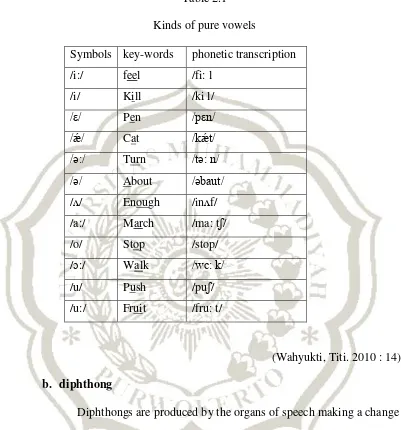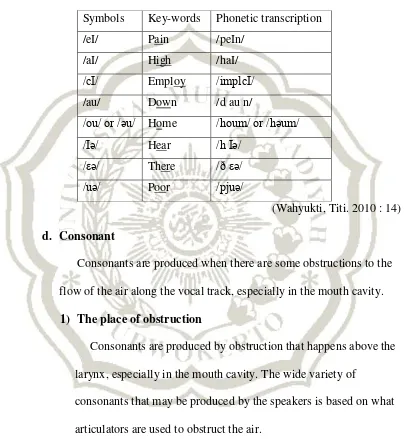CHAPTER II
THEORETICAL REVIEW
A. The Nature of Pronunciation
1. Definition of pronunciation
Pronunciation is from the verb pronounce. According to Hornby (1995 : 928) to pronounce is to make the sound of a word or letter particularly way. It means that pronunciation is the way to produce a sound of a word or letter. Pronunciation refers to the production of sounds that we use to make meaning.
According to Ramelan (1985:5) pronunciation is one of the most important components of English to make oral communication with others. When we communicate orally with other people we should not only have a good vocabulary but also have good pronunciation.
Based on the statement previously, the writer concludes that pronunciation is the way to produce the sound of a word or letter of language. Pronunciation also called as the production of the speech sound.
2. The English Speech Sounds
21
writing. The symbols are called „Phonetics Transcription‟. For instance: /ʃ/, /ʒ/, /t/, /d/, /b/, /m/, and so on.
Based on the explanation above, we can conclude that speech sound is saying a letter or word to produce a sound by organs. Speech sound is represented by phonetic symbols in English, not by letters (alphabets)
Speech sounds in English are generally divided into three main classes. They are vowel sounds (pure vowel sounds or monothongs), the diphthongs, and the consonant sounds.
a. Pure Vowels (monothongs)
There are twelve kinds of pure vowel: Table 2.1 Kinds of pure vowels
Symbols key-words phonetic transcription /i:/ feel /fi: l
/i/ Kill /ki l/
/ε/ Pen /pεn/
/ǽ/ Cat /kǽt/
/ə:/ Turn /tə: n/
/ə/ About /əbaut/
/ʌ/ Enough /inʌf/ /a:/ March /ma: tʃ/
/o/ Stop /stop/
/ɔ:/ Walk /wс: k/
/u/ Push /puʃ/
/u:/ Fruit /fru: t/
(Wahyukti, Titi. 2010 : 14)
b. diphthong
Diphthongs are produced by the organs of speech making a change in position (from one vowel position to another vowel position), namely the tongue starts in the position of /ε/ and glides forward in the
production of /εi/ as in cake, take, main. In another words, diphthong is
23
c. Kinds of Diphthongs
Table 2.2
Kinds of Diphthongs.
Symbols Key-words Phonetic transcription
/eI/ Pain /peIn/
(Wahyukti, Titi. 2010 : 14)
d. Consonant
Consonants are produced when there are some obstructions to the flow of the air along the vocal track, especially in the mouth cavity.
1) The place of obstruction
Consonants are produced by obstruction that happens above the larynx, especially in the mouth cavity. The wide variety of
consonants that may be produced by the speakers is based on what articulators are used to obstruct the air.
Most consonants are sounded by the flow of the air through the nose. Thus, the term „consonant‟ cannot be clearly defined, that is
A language learner should master the general mechanism of moving his speech organs in order that he can pronounce the target sounds correctly. The English consonants are distinguished into several types as the following:
a) bilabialconsonants, in which the obstruction is formed by the lower and upper lips. For example /p/, /b/, /m/, /w/.
b) labiodentalconsonants, in which the obstruction are formed by the lower lip in touch with the upper teeth. For example /f/, /v/; the term „labio‟ referring to lip, and „dental‟ refer to
teeth.
c) apico dental or dental, in which the out-going air is obstructed of the tongue and the upper teeth; or the tip of the tongue is between the teeth, for example /θ/ , /ð/
d) alveolarconsonants, in which the obstruction is formed by
some parts of the tongue (either the tip or blade of the tongue) and teeth ride or gum. The examples for the tip of tongue against the teeth ridge are sounds /t/, /d/, /n/, /l/, /s/, /z/, /r/..when the blade of the tongue is in contact with an area slightly back of the teeth ridge, the sounds are /ʃ/, /ʒ/; these are called palato-alveolar consonants.
25
f) velar consonants, in which the air obstruction is formed by raising the back or dorsum of the tongue in contact with the soft palate or velum, for example: in producing /k/, /g/, /η/; these may also be called dorsovelar consonants.
g) glottalconsonants, in which the obstruction of the air is formed at the glottis, that is either by putting the two vocal cords in close contact or by separating them, for example /h/. /?/
2) Manner of Obstruction
The types of consonants are also determined by the way how the air is obstructed or by the manner in which the air is interrupted. The air passage may be either completely closed or partially
obstructed by two articulators in the production of consonants. English consonants have several types, they are:
a) plosive or stop consonants
Plosive are consonants with the characteristics that when they are produced; two articulators are moved against each other so as to form a complete obstruction or a stricture that no air can escape. After the air is allowed to escape with a slight puff or explosive sound; for example in the
b) fricative consonant
Fricative are consonants with the characteristic tat when they are produced, the out going air is partially obstructed; it is because the two articulators come closer to each other in such a way that there is a narrow opening left for the air to escape. When the air is forced to go out through a small passage, this cause a frictional or a hissing sound; such as /f/, /v/, /θ/, /ð/, /s/, /z/, /ʃ/, /ʒ/, /h/.
c) affricate consonant
Affricates are rather complex consonants. They begin as plosives and end as fricative. It is the same as a plosive in that there is a complex obstruction somewhere along the speech tract at the beginning; but then this closure is gradually released so that the plosive sound is immediately followed by a frictional sound. For examples: /tʃ/, /dʒ/. d) nasal consonant
In the production of nasals, the air passage is completely closed at some point in the mouth cavity so that the air can pass. But the soft palate is lowered that is why the air can go out through the nasal cavity, as sounds /m/, /n/, /η/. e) lateral consonant
27
teeth ridge) at the centre of the mouth, so that the air passes out through one side or both sides of the tongue; the nasal cavity is closed by raising the soft palate. The lateral consonant is /l/.
f) semi-vowels or Glide Consonant
Semi-vowels consonants have another name that is „approximant. The way of producing semivowels is the
same as that of producing vowels, but they function as consonants. In short, they are phonetically like vowels but phonologically like consonants. The sounds: /j/, /w/ belongs to semivowels.
3) The movement of vocal cords
Based on the variable, the English consonants are classified into two groups: voiced and voiceless. There are same pairs of consonants with the same place and manner of obstruction.
Voiceless : /p/, /t/, /k/, /f/, /θ/, /s/, /ʃ/, /tʃ/, /h/. Voiced : /b/, /d/, /g/, /v/, /ð/, /z/, /ʒ/, /dʒ/,
/m/ /n/, /η/, /l/, /r/, /w/, /j/.
4) Chart of English Consonants
Table 2.3
manner of
articulation
point of articulation
Bilabial labio
dental Dental alveolar
palato
alveolar palatal velar glottal
vl vd vl vd vl vd vl vd vl vd vl vd vl vd vl vd
3. The importance of learning English pronunciation
29
On the other hand, if they are good at pronouncing words, the listeners judge the speaker‟s overall language ability is good.
a. In general
a) Native speaker will comprehend their pronunciation. In the
daily life, we can meet native speaker in public area such as in the temple, beach, mountain and so on, if we have good pronuncation, we can speak in enoyable conversation. Besides, the native speakers will catch our words.
b) There is no embrassment for speaker or listener. If we have
conversation with native speakers and we are good pronunciation, we have not embrassment to speak up with them. We enjoy the conversation without any humming.
b. In classroom Actvities
a) The students will get good score in speaking activities. We know that pronunciation is one of the important components in speaking skill. The teacher can assess the students‟
pronunciation. If she/he has a good pronunciation, she/he will get good or best score n speaking activities.
4. The factors influencing pronunciation mastery
There are many factors that can influence the learning and teaching of pronunciation skills (Cunningham, 2002:1)
1. Age.
Some researchers argue that the age will affect the performance of the brain or other organs. The more mature person's increasingly difficult to learn something. For example, learn about pronunciation in early childhood will be more easily absorbed than adulthood.
2. Ability.
All the learners have same chance to learn something. In this case, the students can study pronunciation in the same opportunity. But, their ability to learn pronunciation is different. The differentiation of the learners‟ ability can influence pronunciation.
3. Learners‟ attitude and motivation.
Learners‟ attitude toward the target language and their motivation to
learn pronunciation can support or obstruct the development of pronunciation.
5. The problem in pronunciation
According to Titi Wahyukti (2010 : 4), there are some problems in pronunciation. The problems are:
31
2. The learning of the new sound system, the learning of the new vocabulary system and how to apply words into the unfamiliar sentences patterns of the language.
3. The written form is different from the spoken form as happens in English. When Indonesian learners see a word „table‟ for example, they will say /tabel/ not /teibəl/ or others. But in English written form
is different with spoken form. The word „enough‟ for example, it will
sound /inʌf/
4. The difficulty of the movements of his speech organ to produce the
speech sounds. It will be difficult for him to change the habit of moving his speech organ to produce the foreign speech sounds.
The difficulties faced by the learners in studying a foreign language is caused by the different elements found between their own language and the target language. The learners are confused to identify the foreign sounds.
The differences between own language and target language can be seen in the vowels, diphthongs, and consonants. But there are similarities between the sound system of Indonesian and English. For example /a/, /i/, /u/, /e/, /o/, /p/, /t/, /d/, /g/, /h/, and so on.
B. Basic Assumption


